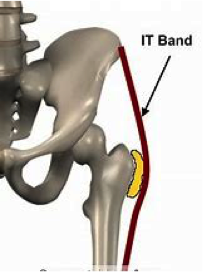What is a Bursa?
October 01, 2019

A bursa is a small fluid filled sac that provides a cushion and allows smooth movement between soft tissues, like muscles and tendons, and hard bone. It is like having a small water balloon, ie the bursa sac between a hard corner, ie the bone and a piece of rope, ie the tendon, so the rope won’t fray. It is a malleable and thin structure that will not burst. You have bursa all over your body and they are a normal structure in your body that reduce friction and allow smooth movement between different tissues in your body.

In this image of the hip, it illustrates the bursa between the bony prominence (that you can feel at the top of your outer thigh) of the greater trochanter and the soft tendon of the Iliotibial (IT) band. The earlier picture depicts some of the many bursa that sit around your knee.
Bursae (plural of bursa) can become inflamed with excessive friction, an injury, trauma or an underlying condition such as rheumatoid arthritis. This is known as bursitis, which is the term you may have heard after seeing the physio or after a scan. The bursal sac thickens, and more liquid is produced inside the sac causing a swelling effect. Bursitis is most common in the shoulder and hip but can occur throughout your body. The most common symptom is pain and it can feel warm, swollen and appear red. Conservative treatment through physiotherapy is about getting the surrounding muscles strong and working properly. It can also involve changing positional habits and identifying aggravating factors and eliminating them. Anti-inflammatories and ice are often helpful. More aggressive treatment can involve an injection of corticosteroid into the bursal sac or in severe cases a surgical removal of the bursa.
The take home message is that bursae are a necessary and normal structure in your body. The problem is when they become inflamed and sore from an injury or overuse.
Written by: Lachlan Oberg
